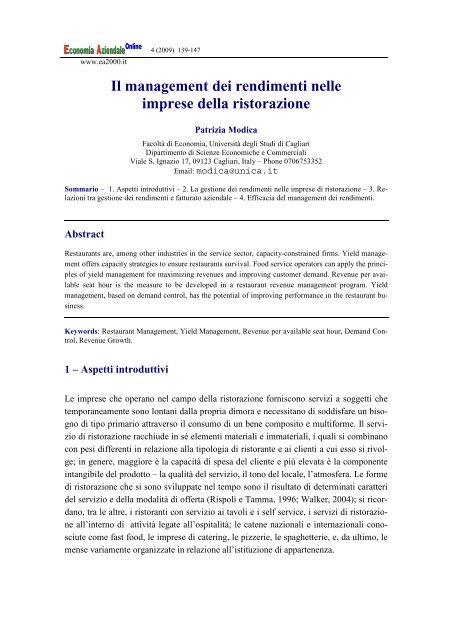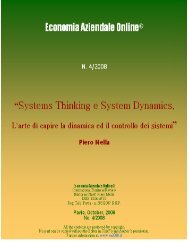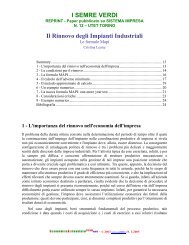Il management dei rendimenti nelle imprese della ristorazione - Riviste
Il management dei rendimenti nelle imprese della ristorazione - Riviste
Il management dei rendimenti nelle imprese della ristorazione - Riviste
Create successful ePaper yourself
Turn your PDF publications into a flip-book with our unique Google optimized e-Paper software.
www.ea2000.it<br />
4 (2009) 139-147<br />
<strong>Il</strong> <strong>management</strong> <strong>dei</strong> <strong>rendimenti</strong> <strong>nelle</strong><br />
<strong>imprese</strong> <strong>della</strong> <strong>ristorazione</strong><br />
Patrizia Modica<br />
Facoltà di Economia, Università degli Studi di Cagliari<br />
Dipartimento di Scienze Economiche e Commerciali<br />
Viale S. Ignazio 17, 09123 Cagliari, Italy – Phone 0706753352<br />
Email: modica@unica.it<br />
Sommario – 1. Aspetti introduttivi – 2. La gestione <strong>dei</strong> <strong>rendimenti</strong> <strong>nelle</strong> <strong>imprese</strong> di <strong>ristorazione</strong> – 3. Relazioni<br />
tra gestione <strong>dei</strong> <strong>rendimenti</strong> e fatturato aziendale – 4. Efficacia del <strong>management</strong> <strong>dei</strong> <strong>rendimenti</strong>.<br />
Abstract<br />
Restaurants are, among other industries in the service sector, capacity-constrained firms. Yield <strong>management</strong><br />
offers capacity strategies to ensure restaurants survival. Food service operators can apply the principles<br />
of yield <strong>management</strong> for maximizing revenues and improving customer demand. Revenue per available<br />
seat hour is the measure to be developed in a restaurant revenue <strong>management</strong> program. Yield<br />
<strong>management</strong>, based on demand control, has the potential of improving performance in the restaurant business.<br />
Keywords: Restaurant Management, Yield Management, Revenue per available seat hour, Demand Control,<br />
Revenue Growth.<br />
1 – Aspetti introduttivi<br />
Le <strong>imprese</strong> che operano nel campo <strong>della</strong> <strong>ristorazione</strong> forniscono servizi a soggetti che<br />
temporaneamente sono lontani dalla propria dimora e necessitano di soddisfare un bisogno<br />
di tipo primario attraverso il consumo di un bene composito e multiforme. <strong>Il</strong> servizio<br />
di <strong>ristorazione</strong> racchiude in sé elementi materiali e immateriali, i quali si combinano<br />
con pesi differenti in relazione alla tipologia di ristorante e ai clienti a cui esso si rivolge;<br />
in genere, maggiore è la capacità di spesa del cliente e più elevata è la componente<br />
intangibile del prodotto – la qualità del servizio, il tono del locale, l’atmosfera. Le forme<br />
di <strong>ristorazione</strong> che si sono sviluppate nel tempo sono il risultato di determinati caratteri<br />
del servizio e <strong>della</strong> modalità di offerta (Rispoli e Tamma, 1996; Walker, 2004); si ricordano,<br />
tra le altre, i ristoranti con servizio ai tavoli e i self service, i servizi di <strong>ristorazione</strong><br />
all’interno di attività legate all’ospitalità; le catene nazionali e internazionali conosciute<br />
come fast food, le <strong>imprese</strong> di catering, le pizzerie, le spaghetterie, e, da ultimo, le<br />
mense variamente organizzate in relazione all’istituzione di appartenenza.

















